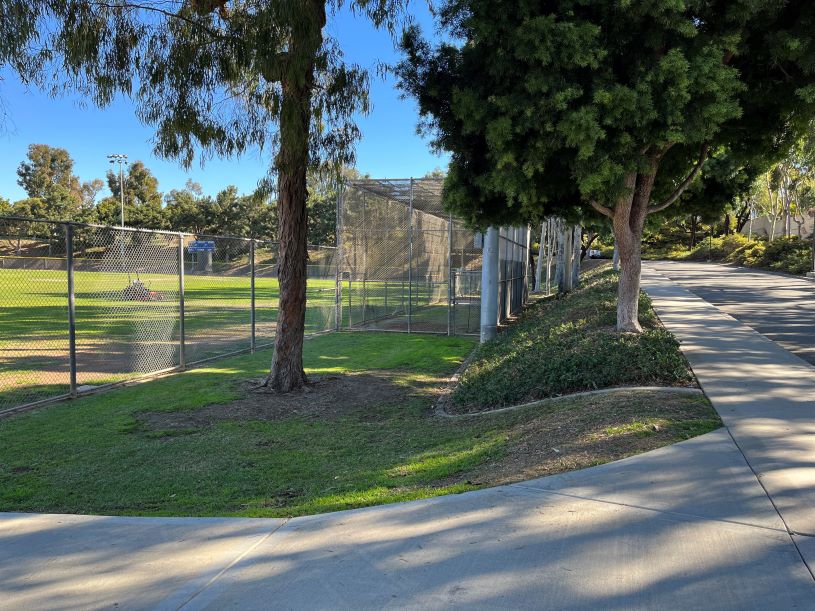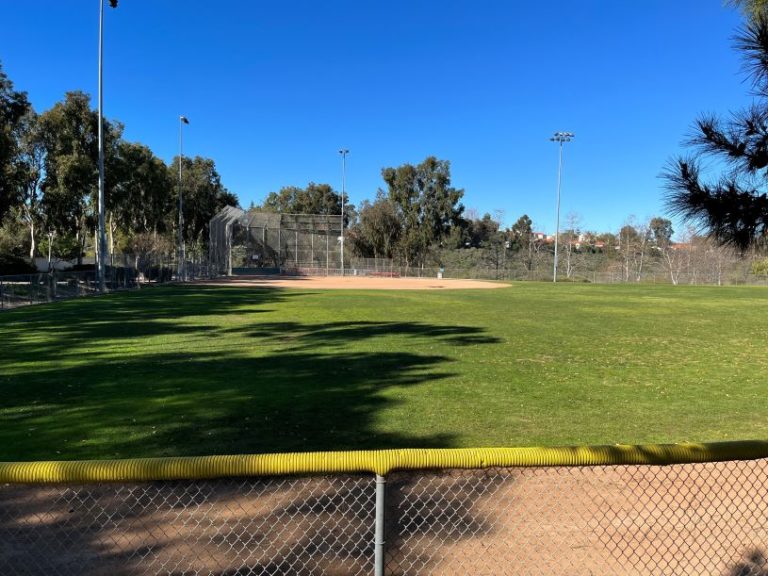By John C. Fech
When trees near a sports field, in a park or on a campus grounds become problematic, removal is a good option. However, knowing when a tree is really problematic or just looks problematic is a really tough endeavor indeed. An extra caveat is that tree removal is a political football, with emotional complications and challenges. With all of this in mind, sports field managers need to get it right; to remove the bad ones and keep the good ones. The step-by-step process of assessing the condition, seeking guidance from a certified arborist, identifying and prioritizing specimens, communicating effectively with stakeholders, and implementing the plan will bring success to a sometimes daunting endeavor.
Start where you can
When faced with a big concern like tree removal, it can be difficult to know how and where to start. Most often, this is because the task seems overwhelming. Instead of feeling the need to tackle and accomplish the entire objective/outcome, it’s often helpful to lower the expectation a bit – especially if you’re not totally equipped or you’ve never done this before. A guiding phrase from tennis great Arthur Ashe provides some excellent advice in this regard: “Start where you are, use what you have, do what you can.” Considering the obstacles that he was able to overcome and the achievements that he made, it’s especially pertinent. With tree removal:
- Start where you are – Every sports field manager has had to define and implement various projects; this is just one more. Use the skills that are general in nature and transfer them to this project.
- Use what you have – Whether it’s advice from a neighbor who has recently had a tree removed or watching a YouTube video featuring an ISA Certified Arborist, reliable information is readily available.
- Do what you can – Even if it’s only making a list of trees that appear to be problematic, a simple step can be very impactful.
Problem identification
When deciding which trees to work on first, start with the ones that appear to have something wrong with them. The obvious defects of cracks, previous topping procedures, soft/spongy wood, missing bark and sapwood at the base, and lots of stems that occupy the same general space are easy to spot.
Defect “look alikes” can be a little tricky, but are similar to actual defects in that they are conditions to note on a list of concerns. The ones that fall into this category are burls, exfoliating bark and root knees. These naturally occurring features of trees are not actual problems, they just look like it.

Tree location
Just like with residential housing or commercial real estate, location is very influential in navigating tree removals. For example, trees often cause problems with casting excessive shade, creating surface roots and droppage of debris. If located close to the playing surface of a sports field or walking path on school grounds, it’s not so much the tree itself that is the issue, it’s the conflict with the purpose of the site (aka, the location).
In some cases, the opposite is the problem – the site itself is the issue, as in situations where more water or fertilizer is applied to maintain turf than is beneficial for the tree. This is certainly the case with herbicides that control broadleaf weeds. Turf maintenance equipment such as mowers and string trimmers pose threats to tree health, often causing damage to the bark and sapwood, which disrupts the movement of water and nutrients and often leads to decay of the heartwood.
Another consideration of location is the suitability of the site for the tree’s health. The common phrase of “right plant, right place” rings true here. A good technique for this factor is to ask, “is this a good spot for a (fill in the blank) tree, or, actually, any tree at all?” After all, some trees are planted “just because,” and not for any real purpose. For overall tree vigor, consider size, shape, sun/shade preferences, fall color, spring bloom, disease resistance and other redeeming characteristics.
Finally, in terms of location, does the tree have to be removed or can it just be “fixed” or mitigated through pruning, cabling/bracing, radial trenching, relocation or root excavation? In some situations, trees don’t have to be cut down; rather they can be stabilized or modified to remain as an asset in the sports field or grounds landscape. This can be beneficial if a key stakeholder has a special interest in a given tree, or if it has historical or memorial significance.
If any suspected tree problem or location issues are in doubt, it’s best to consult with a qualified professional. Highly competent tree professionals establish and maintain their skill sets through the International Society of Arboriculture (ISA). Various categories of certification exist; the ones that pertain to this arena are the ISA Certified Arborist, the ISA Tree Risk Assessment Qualification and the ISA Board Certified Master Arborist.

Prioritizing the removals and remediations
Some trees are more problematic than others. Consider safety to players, spectators and landscape users as the highest priority, move on to threats to turf health, and then to general lack of aesthetic appeal.
Create a priority list with columns for tree species and location, identified issue/concern, proposed solution and follow-up evaluation – timeframe to be determined, usually six months later. The priority can be framed by field, by historic complaints, or by inputs from staff and stakeholders. As with problem identification, assistance from an ISA Certified Arborist can be very helpful during prioritization.

Communicating with decision makers
It’s probable that at least some removals will need approval from a field owner, department manager, athletic director or other stakeholder. It’s rare that a sports field manager has total control over these sorts of decisions. With that in mind, persuading or at least communicating intent becomes a key component of navigating tree removals. A few considerations of the other person(s) in the equation can smooth out the process.
First, consider the background and specific personality of the “pitchee,” – the person being persuaded or informed. Most people favor credibility, act emotionally and think logically; usually it’s a combination thereof, skewing in one of these categories, much like being an introvert or extrovert. Even the most reserved and quiet person has some degree of outward expression. It’s helpful to know beforehand which is their preference or at least a tendency. “Hot buttons” are similar, such as a desire to see color on the campus grounds or have water features near the field.
Like knowing the innate or chosen preferences of another person, being privy to their awareness of the need to remove trees can be very helpful as well. Convincing someone that removal is necessary is easier if they already know that there is some sort of need to do something to a particular tree that they’ve observed. The movie character Jordan Belfort in “The Wolf of Wall Street” utilized this principle to his maximal advantage – after all you can’t write your name if you don’t have a pen.

Communication helpers and hinderers
As with most things in life, communication can either be smooth or rough. Being successful hinges on knowing what works and what doesn’t.
In addition to knowing the background of a pitchee, being specific and clear about the proposed action makes a big difference. As David Horsager, author of “The Trust Edge” explained, “People trust the clear and mistrust the ambiguous or overly complex.” In this context, site-specific tree defects, costs and risks should be described clearly and concisely.
Being aware of potential “interrupters” and “blockers” is also helpful. Common ones include time and attention, initial perceptions, competition with other projects, available funds, expected return on investment and too much work/too little focus.
Being aware of “noises” and distractions; noises can be actual sounds or related elements such accents, body language, facial expressions, preconceived notions, ringing in the ears and background noises. Even industry jargon – such as IPM, Poa and PGRs – can be problematic. Finally, “non-answers” can get in the way of effective communication. When a question is asked and it is not directly answered, the listener must figure out why their question didn’t merit the response they were looking for, resulting in a disruption in the information exchange.
Listening actively. Here’s a challenge – in conversation, do you listen, or do you wait to talk? Pausing to focus on the message that your conversation partner is delivering is not only polite, but it also helps prevent missing key information in their response, allows them adequate time to finish what they are saying, and provides a bit of time for you to formulate your response. A good way to fully consider what your pitchee is saying is to take a cue from Steve Covey, author of “The 7 Habits of Highly Effective People,” to seek first to understand before being understood. If someone feels like they are being understood, they feel affirmed – like their opinion is valued – and are more likely to agree with the need for tree removal.
Essential pitching point techniques also include KISS (Keep It Short Sweetheart), making it visual, being unassailable, emphasizing burden relief and problem solving (aka, WIIFM – What’s In It For Me?), sweetening the case with one more benefit, timing and preplanning any decision-maker objections.
Finally, in addition to evaluation after tree removal, replanting guidelines are the final step in navigating tree removal. Perhaps the most effective mindset is to consider where existing trees are problematic due to location and pests. Toss in purpose of the tree, selecting from a large plant palette to create a diverse landscape and maintenance considerations of the species chosen and replanting becomes well planned and poised to be highly successful.
John C. Fech is a horticulturist with the University of Nebraska-Lincoln and certified arborist with the International Society of Arboriculture. The author of two books and more than 400 popular and trade journal articles, he focuses his time on teaching effective landscape maintenance techniques, water conservation, diagnosing turf and ornamental problems, and encouraging effective bilingual communication in the green industry.


